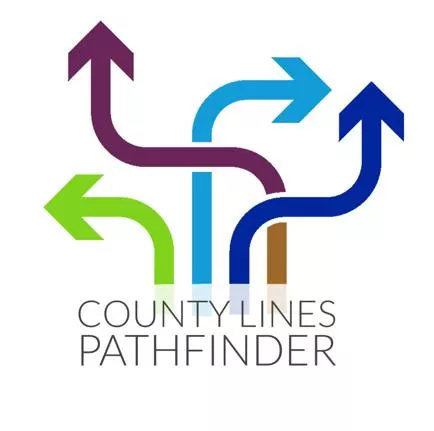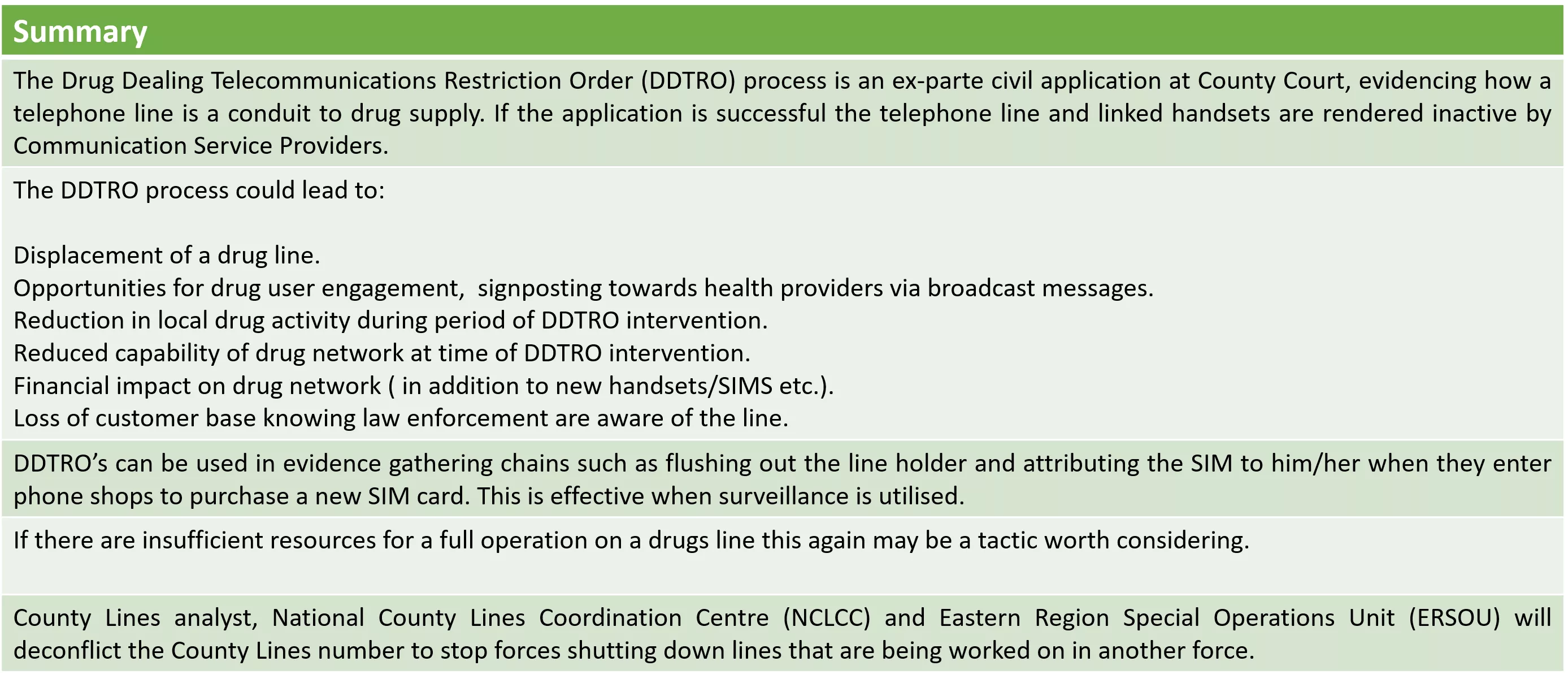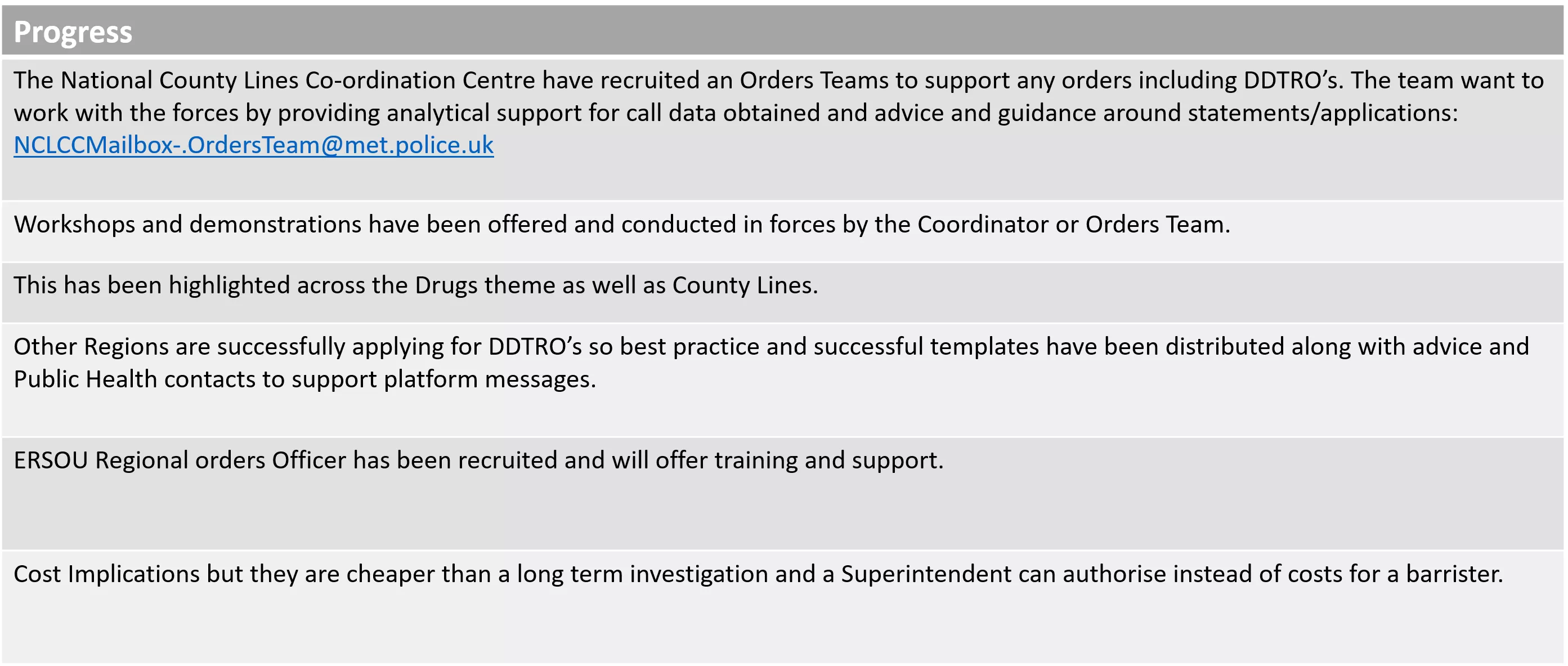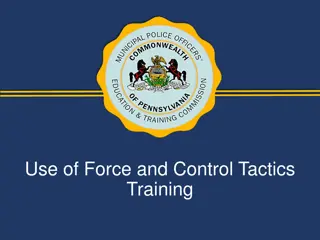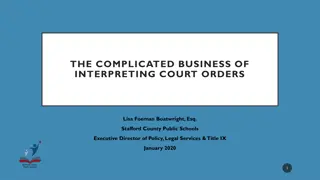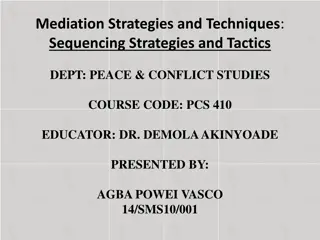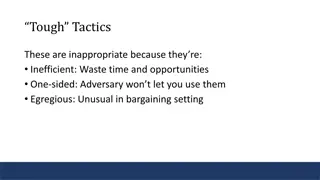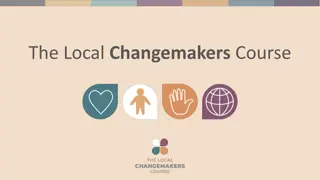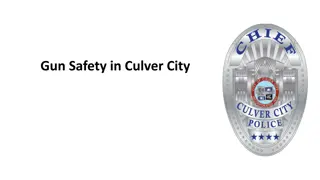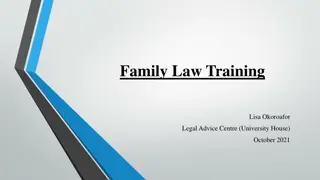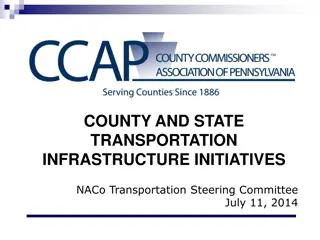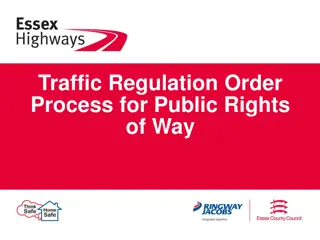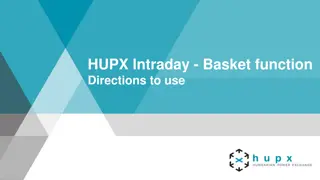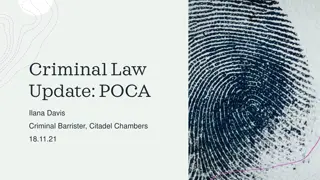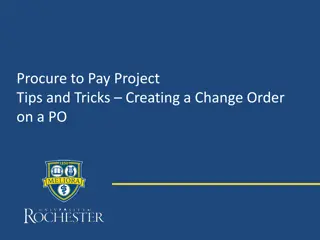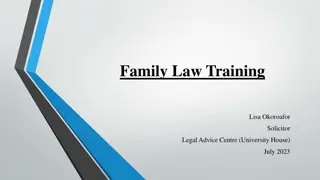Using Tactics and Orders to Disrupt County Lines: Case Studies and Strategies
Exploring the approach of using tactics and orders to disrupt county lines, this content outlines the Drug Dealing Telecommunications Restriction Order (DDTRO) process and its impact on drug supply chains. Case studies like the successful DDTRO conducted by the North West Regional Organised Crime Unit highlight the effectiveness of interventions such as rendering telephone lines inactive, displacing drug lines, and engaging with drug users for health support. The involvement of Orders Teams, analytical support, and training initiatives underscores collaborative efforts in combating county lines activities.
Download Presentation

Please find below an Image/Link to download the presentation.
The content on the website is provided AS IS for your information and personal use only. It may not be sold, licensed, or shared on other websites without obtaining consent from the author. Download presentation by click this link. If you encounter any issues during the download, it is possible that the publisher has removed the file from their server.
E N D
Presentation Transcript
USING TACTICS AND ORDERS TO DISRUPT COUNTY LINES INFORMATION AND CASE STUDIES Kelly Gray Regional County Lines Coordinator Eastern Region Special Operations Unit
Drug Dealing Telecommunications Restriction Order (DDTRO) Summary The Drug Dealing Telecommunications Restriction Order (DDTRO) process is an ex-parte civil application at County Court, evidencing how a telephone line is a conduit to drug supply. If the application is successful the telephone line and linked handsets are rendered inactive by Communication Service Providers. The DDTRO process could lead to: Displacement of a drug line. Opportunities for drug user engagement, signposting towards health providers via broadcast messages. Reduction in local drug activity during period of DDTRO intervention. Reduced capability of drug network at time of DDTRO intervention. Financial impact on drug network ( in addition to new handsets/SIMS etc.). Loss of customer base knowing law enforcement are aware of the line. DDTRO s can be used in evidence gathering chains such as flushing out the line holder and attributing the SIM to him/her when they enter phone shops to purchase a new SIM card. This is effective when surveillance is utilised. If there are insufficient resources for a full operation on a drugs line this again may be a tactic worth considering. County Lines analyst, National County Lines Coordination Centre (NCLCC) and Eastern Region Special Operations Unit (ERSOU) will deconflict the County Lines number to stop forces shutting down lines that are being worked on in another force.
Progress The National County Lines Co-ordination Centre have recruited an Orders Teams to support any orders including DDTRO s. The team want to work with the forces by providing analytical support for call data obtained and advice and guidance around statements/applications: NCLCCMailbox-.OrdersTeam@met.police.uk Workshops and demonstrations have been offered and conducted in forces by the Coordinator or Orders Team. This has been highlighted across the Drugs theme as well as County Lines. Other Regions are successfully applying for DDTRO s so best practice and successful templates have been distributed along with advice and Public Health contacts to support platform messages. ERSOU Regional orders Officer has been recruited and will offer training and support. Cost Implications but they are cheaper than a long term investigation and a Superintendent can authorise instead of costs for a barrister.
Case Study Case Study The North West Regional Organised Crime Unit (NWROCU) conducted a successful DDTRO in 2020 against the BEAR TEAM (the name associated with controlling the line). These perpetrators had been operating in a town in Cheshire for about 6 months, and despite several Warrants, Police were unable to obtain the Phone Line. They conducted a DDTRO, and upon closure of the line, they combined it with a broadcast message of their own to the client list they had obtained from the Telecoms data. The body of this message identified them as contacting the Bear Team, and directed them to a Drugs Rehabilitation Programme in the local area. Over the coming weeks they also conducted several warrants, house closures and placed disruption teams in the area for the days immediately following the DDTRO. This was aimed at targeting the runners, but also generating intelligence as to how quickly they took the line back up. From speaking with local users in the following days, some of whom had received the broadcast message from the Police, they stated that it had caused a great deal of unrest within the drug user community as everyone believed the Police were watching them. Users/dealers were ditching their phones as they believed the Police had them under surveillance. The line disappeared for six months although there was been intelligence they had returned (in 2021) looking for a new address to set up from. Another of NWROCU DDTRO for a Team operating out of another town in Cheshire yielded similar results, and the team even made its users walk to Merseyside to pick the drugs up as they did not want to cross over to Cheshire as they believed it was too Hot .
Pester / TDOS Pester / TDOS Summary TDOS method (Temporary Denial of Service), otherwise known as PESTER, is a tactic used to deny the user the opportunity to use the telephone number for a criminal enterprise, to stop / cease the modus operandi of the organised crime group. The TDOS method deprives drugs dealers of income the disruption in their business can be costly to them and creates distrust amongst their customers . TDOS is used to contact the customer base of a county line. This is usually done either following the seizure of a line, or when all reasonable lines of enquiry to locate a line have failed and as a last resort to disrupt the lines activity. Prior to utilisation of the tactic, appropriate legal advice was received and both the Information Commissions Office and OFCOM have been made aware. There is no court process involved. Either a limited number of messages are sent to the deal line or all callers to the line are sent a message, which is a tactic that can be used after enforcement on a County Line. This site signposts the contact to support organisations who can provide help and support around addiction and exploitation. A contact email address is also provided for the force if the person wants to provide information. Any intelligence gathered through this process is fed back into the relevant force and consideration is given to opportunities around CHIS recruitment/development.
Progress The National County Lines Co-ordination Centre have recruited an Orders Teams to support any orders including PESTER. The team want to work with the forces by providing analytical support for call data obtained and advice and guidance around statements/applications: NCLCCMailbox-.OrdersTeam@met.police.uk Workshops and demonstrations have been offered and conducted in forces by the Coordinator or Orders Team. This has been highlighted across the Drugs theme as well as County Lines. Other Regions are successfully using the Pester so best practice and successful templates have been distributed along with support networks and approves companies to maintain the integrity of the data. ERSOU Regional orders Officer has been recruited and will offer training and support. Cost Implications but they are cheaper than a long term investigation with no cost if run internally by the force.
Case Study Case Study Bedfordshire have been using the Pester tactic in two different ways. They send out a message to the deal line holder which are they are looking to pester saying something similar to:- This is Bedfordshire Police . We are committed to tackling and disrupting the supply of controlled drugs and protecting vulnerable people. We have taken control of your line (Name insert) We have sent a text to all your customers. If you need support with an addiction or feel you are being forced to sell drugs, call Police on 101 or 999 in an emergency. For support and advice: England: Talk to FRANK 0300 123 6600 Bedford: Path 2 Recovery 0333 332 4019 Crime stoppers on 0800 555 111 England: Talk to FRANK 0300 123 6600 Bedford: Path 2 Recovery 0333 332 4019 VERU: VERU@bedfordshire.pnn.police.uk Crime stoppers on 0800 555 111
Case Study Case Study They will also send one out to all the customers identified with something along the lines of:- This is Bedfordshire Police. Your number has been identified as being in contact with a County line known as the (Insert name here) County line, which supplies controlled drugs in the area of Bedfordshire and we have taken control of this line. We are committed to tackling and disrupting the supply of controlled drugs and protecting vulnerable people. We also understand that people swap and barrow phones to send texts and call people, so If you feel this message does not apply to you, please understand it is sent with good intentions to offer help and support. If you have any information that would assist us in tackling drug supply, send a text or call us back and leave a message. If you need support with an addiction or feel you are being forced to sell drugs, call Police on 101 or 999 in an emergency. For support and advice: England: Talk to FRANK 0300 123 6600 Bedford: Path 2 Recovery 0333 332 4019 VERU: VERU@bedfordshire.pnn.police.uk Crime stoppers on 0800 555 111 The Pester tactic is a unique way of obtaining intelligence from the customer base of a County line who are deemed as a hard to reach demographic. The use of this tactic has proven that the recipients do respond, either via text message or voicemail providing intelligence that would not have been forthcoming previously. It is a hypothesis that customers of drug networks feel a degree of anonymity in providing intelligence via text message. They have successfully completed, a two-way intel flow from the users, lines have been turned off or moved. One line moved from Luton to Bedfordshire. The use of this tactic has been at limited cost and has resulted in numerous disruptions.
Gang Injunctions Summary Gang injunctions help to prevent gang-related violence and rehabilitate gang members. The purpose of obtaining Gang Injunctions is not for the purpose of enforcement. Enforcement is the consequence of failing to comply with the opportunities presented to them to seek a law- abiding lifestyle and accept the support being offered/provided. The objectives of gang injunctions can include: Reduce violent street and gang crime in an area To disrupt and dismantle the activity of Urban Street Gangs and County Lines. To reducing the level of readily available firearms and weapons and street violence between these rival gangs and County Lines. To fast-track safeguarding and diversion opportunities with those being exploited by Urban Street Gangs and County Lines. To Force diversion from these criminal activities and make persons Too hot to handle by the Urban Street Gangs and County Lines. To make Essex a hostile environment for Urban Street Gangs and County Lines. To Help People, Keep People Safe and Catch Criminals. Introduced in the Policing and Crime Act 2009, gang injunctions allow the police and local authorities to apply to a county court (or the High Court) for an injunction against an individual who has been involved in gang-related violence. Gang injunctions allow courts to place a range of prohibitions and requirements on the behaviour and activities of a person involved in gang-related violence. These conditions could include prohibiting someone from being in a particular place or requiring them to participate in rehabilitative activities. Gang injunctions are a valuable tool in preventing gang-related violence alongside a range of other prevention, detection and enforcement measures.
Progress The National County Lines Co-ordination Centre have recruited an Orders Teams to support any orders . The team want to work with the forces by providing analytical support for call data obtained and advice and guidance around statements/applications: NCLCCMailbox- .OrdersTeam@met.police.uk Workshops and demonstrations have been offered and conducted in forces by the Coordinator or Orders Team. This has been highlighted across the Drugs theme as well as County Lines. Other Regions are successfully applying for gang injunctions so best practice and successful templates have been distributed along with advice. ERSOU Regional orders Officer has been recruited and will offer training and support. Cost Implications but surge funding can support this piece of work and for Section 50 of the Policing and Crime Act 2009 requires a review of gang injunctions. The process and maintenance of Gang Injunctions is a complex and extensive process, which is resource intensive to manage with difficulties of breaches being heard within County Courts and the legal processes surrounding this. However, the benefits once implemented are for all to see.
Case Study Case Study In line with a long term operation, a number of Gang Injunctions were sought and obtained against 3 prominent Urban Street Gangs operating within a local area and in direct conflict. These Gangs are heavily involved in Serious Violence, County Lines Drug supply and in the last 18 months been responsible for 3 murders/deaths. The most recent murder was committed in early 2021 during a dispute whereby the victim was stabbed in the heart. The local Serious Violence Unit have now implemented applications for Gang Injunctions to be imposed against all 3 gangs, in order to force diversion from those that are actively involved and make it difficult for the gangs to operate. The information around the Gangs is vast and embedded within the Gang Injunction applications. To date the Serious Violence Unit, have successfully achieved 20 x Gang Injunctions. (18 x Full and 2 x Interim) against these gangs.
Case Study Case Study Results as of December 2020
Slavery and Trafficking Risk Orders (STRO) Summary These civil orders enable courts to place restrictions on the activities of individuals believed to be at risk of modern slavery offending. STRO should not be used as an alternative to prosecution. STROs can be made in respect of individuals at risk of offending same way as Sexual Risk orders are used to manage those who prevent a sexual risk to others) , where an Order is considered necessary to protect against the risk of harm to others from the defendant committing the offence. STRO s could be considered as a risk management tool for suspects who present a criminal exploitation risk to others. Unlike STPO ( slavery and trafficking prevention orders), they do not require a conviction or a failed conviction. When looking at County Lines STROS consider prohibitions linked to transport and transport hubs for trains, coaches, buses and taxis. Think about the business model for the type of criminality that you are looking at, the methodology, the processes, vehicles, phones, computers, or other equipment; think about those who are exploited (who are you seeking to protect), and try and to come up with appropriate prohibitions (they need to be necessary and proportionate, and any breach needs to be enforceable), to reduce the risk of offending and prevent exploitation. When applying for a STRO it is best practice to explain in some clear detail what the type of exploitation is and how the criminal business model operates. This will make it easier for the magistrates to understand what has been taking place, what the risk is, and why you need the prohibitions that you have requested. There is no age limit or restriction. STRO s can be used against juveniles and adults alike! This is particularly helpful in a county lines context where we often see juveniles recruiting other juveniles.
Progress The National County Lines Co-ordination Centre have recruited an Orders Teams to support any orders including Risk Orders. The team want to work with the forces by providing analytical support for call data obtained and advice and guidance around statements/applications: NCLCCMailbox-.OrdersTeam@met.police.uk Workshops and demonstrations have been offered and conducted in forces by the Coordinator or Orders Team. This has been highlighted across the Drugs theme as well as County Lines. Other Regions are successfully applying for STRO s so best practice and successful templates have been distributed. ERSOU Regional orders Officer has been recruited and will offer training and support. Cost Implications but they are cheaper than a long term investigation. NCLCC orders team have released a guidance document offering support and tactical advice for STPO s, STRO s and DDTRO s.
Case Study Case Study A suspect from Surrey was found with 3 adults and a 15 year old male, in Cardiff. In 2020 officers attended the venue, which was not the home address of the identified nominal (which was known as a previously cuckooed address) to conduct a welfare check. Once officers entered the venue and the occupants were searched, one male was found to be in possession of 94 wraps of heroin and 1 wrap of crack cocaine. The child was seen to attempt to throw away 26 wraps of Crack cocaine. It was established during the investigation that this child was subject of a CAWN relating to the identified suspect. The child stated they had attended the venue of their own free will, but when their phone was examined there were internet searches for the details of a murder which the suspect had previously been acquitted of. This clearly showed that the child was aware of the incident and it had an impact on the suspect s control over this child. The suspect was not in possession of any drugs or phone and the CPS have declined to charge him without further evidence. Therefore a STRO was sought and granted.
Slavery and Trafficking Prevention Orders Summary These civil orders enable courts to place restrictions on the activities of individuals believed to be at risk of modern slavery offending. Sentencing guidelines for Modern Day Slavery released on October 2021 have indicated Judges must consider a civil order on conviction STPOs can be made in respect of individuals who have been convicted of (or cautioned for) slavery or human trafficking offences or equivalent offences abroad. STPO s can be made in respect of individuals at risk of offending same way as Sexual Risk orders are used to manage those who prevent a sexual risk to others) , where an Order is considered necessary to protect against the risk of harm to others from the defendant committing the offence. STRO s could be considered as a risk management tool for suspects who present a criminal exploitation risk to others. When looking at County Lines STPO s consider prohibitions linked to transport and transport hubs for trains, coaches, buses and taxis. Think about the business model for the type of criminality that you are looking at, the methodology, the processes, vehicles, phones, computers, or other equipment; think about those who are exploited (who are you seeking to protect), and try and to come up with appropriate prohibitions (they need to be necessary and proportionate, and any breach needs to be enforceable), to reduce the risk of offending and prevent exploitation. There is no age limit or restriction. STRO s can be used against juveniles and adults alike! This is particularly helpful in a county lines context where we often see juveniles recruiting other juveniles.
Progress The National County Lines Co-ordination Centre have recruited an Orders Teams to support any orders including Risk Orders. The team want to work with the forces by providing analytical support for call data obtained and advice and guidance around statements/applications: NCLCCMailbox-.OrdersTeam@met.police.uk Workshops and demonstrations have been offered and conducted in forces by the Coordinator or Orders Team. This has been highlighted across the Drugs theme as well as County Lines. Other Regions are successfully applying for STRO s so best practice and successful templates have been distributed. ERSOU Regional orders Officer has been recruited and will offer training and support. Cost Implications but they are cheaper than a long term investigation. NCLCC orders team have released a guidance document offering support and tactical advice for STPO s, STRO s and DDTRO s.
Case Study Case Study In 2018 a 16 year old victim Child A was contacted via Snapchat by a friend of his brother, Chris . Child A s brother used to sell drugs with the suspect but had been arrested by Police and was on remand. The suspect asked Child A to help him sell drugs for money and when he refused he was told that he could either help him do it for money or would be doing it anyway. Child A wanted to keep him sweet, so agreed. Child A met the suspect by Paddington train station and was driven in the suspect s vehicle down to Swansea. Child A was aware that he was going to Wales to help with the sale of drugs. He stated that he did not want to go to Swansea and he did not want to sell drugs but felt he had to or the suspect would make him. When they got to Swansea they stayed in several different locations. The suspect would take the calls and Child A was made to deliver the drugs and receive payment. On a couple of occasions Child A was underpaid by the users. The suspect threatened him with violence and told him he would have to stay in Swansea for a year without being paid. When the suspect returned to London to collect more drugs. Child A took this opportunity to leave the address and go to the Police. The suspect was subsequently issued with a 12 year STPO. This subject has an early release date of 05/04/2023. The order states among other requirements that this subject must disclose his home address and contact numbers to the nearest police station to where he resides. Also, to notify the police of any changes to his address or contact details upon his release from custody.
Child Criminal Exploitation Warning Order Summary The most common challenge in policing Child Criminal Exploitation arises from the lack of legislative tools to deter offenders at the early stages of the grooming process. The CCEWN is not intended as a substitute for prosecution where the evidential and public interest grounds exist but is a safeguarding tool. Child Criminal Exploitation Warning Notice derives from the pre-existing Child Abduction Warning Notice (CAWN). Unlike the CAWN, there is no requirement to seek a complainant statement from a victim s parent or care provision. The CCEWN is served on the subject as a blanket warning which encapsulates all exploitative conduct pertaining to any child. Key Advantages Implementation of the Child Criminal Exploitation Warning Notice has the potential to: Enhance our ability to protect vulnerable children. Reduce the number of individual CAWN s issued to repeat offenders. Ensure a more effective contextual safeguarding approach. Create a culture where innovation and further improvements are possible in combatting child exploitation. Improve problem solving and data quality through accurate recording and flagging, supporting a targeted approach. Reduce the demand on frontline officers to enable more time to safeguard, engage and focus on combatting the issue. Support offenders make positive changes to their lifestyle and criminality, casting doubt on inappropriate use of Section 45 defences. Clear documentation and evidence trail to support the application of civil orders. There is no statutory or other legislation provision dealing specifically with the issue of CCEWNs. CCEWNs can provide evidence to support the prosecution of other criminal offences and/or provide evidence that allows for the consideration of using links to other statutory provisions for the safeguarding of children.
Progress The National County Lines Co-ordination Centre have recruited an Orders Teams to support any orders including Anti social orders. The team want to work with the forces by providing analytical support for call data obtained and advice and guidance around statements/applications: NCLCCMailbox-.OrdersTeam@met.police.uk Workshops and demonstrations have been offered and conducted in forces by the Coordinator or Orders Team. This is currently being trailed in Hertfordshire Constabulary so best practice and successful templates have been distributed. ERSOU Regional orders Officer has been recruited and will offer training and support. No cost implications as no case files and authorised by an Inspector.
Case Study Case Study A CCEWN could, for example, be considered for a person associating with a child/ children who repeatedly fails to attend school, has frequent missing episodes or where there are suspicions that inducements have been given. The decision to issue a CCEWN should consider the reliability and timeliness of any intelligence/ allegations; the suspect must be deemed to pose a current safeguarding risk to the child/ children. If there is evidence that the terms of the CCEWN have not been complied with for example, the individual has been seen with a child at risk of exploitation, or a child is subsequently reported missing and is located with the individual, then consider arrest of the individual for a substantive Modern Slavery offence or plan for them to voluntarily attend a police station. Once at the police station an interview should be conducted relating to a suspected offence under the relevant legislation (such as section 2 Modern Slavery Act 2015) or under any other relevant legislation, if it appears that other offences may have also been committed. If there is insufficient evidence to arrest or interview the subject of the notice, full documentation should be made of the interaction. Sufficient documentation should include: Officer MG11 Statement. Recording of relevant intelligence. Where appropriate, Images or video obtained of the conduct as evidence.




